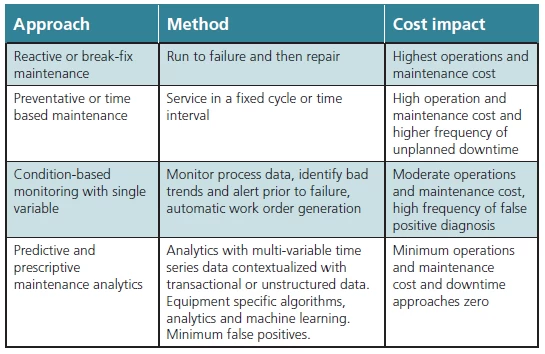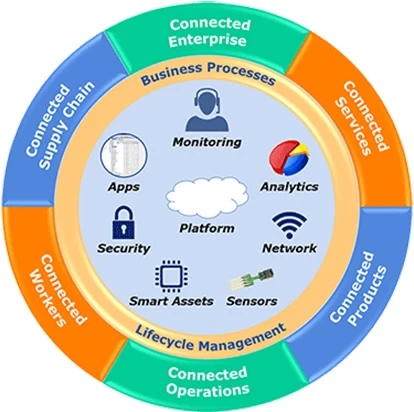Valve maintenance on its way to the cloud
Constanze Schmitz
http://www.valve-world.net/blo
2018-06-17 15:24:50
Edited by Constanze Schmitz, Analyst ARC Advisory Group Europe



___
In the process industries, one of the most important, yet often over-looked assets, are control valves. Without reliable control valve operation, most processes quickly become uncontrollable leading to unplanned downtime.
While operators and maintenance technicians have good basic knowledge and training in the control valves’ mechanical systems, their knowledge often does not extend to the intelligent electronics included in today’s digital positioners. Modern control valve positioners have morphed into digital controllers capable of recording a multitude of parameters affecting control valve operation, e.g. air supply, electrical supply, travel stroke.
Instrument or electrical teams rarely receive adequate training in these increasingly sophisticated and complex devices and are not typically experts in valve diagnostics. Modern digital positioners provide more raw valve health data than ever before but end users are struggling with the sheer volume of data available, making it challenging to obtain full value from the increased diagnostic capabilities provided by their intelligent valve positioners. They also struggle to get a handle on the new work processes needed to get the full value from intelligent valve positioners.
Leading automation suppliers have developed control valve management systems to address this complexity and overcome the site expertise gap. Yet many studies show current practice by most industrial manufacturers is to ignore this feature and simply perform scheduled maintenance or fix the control valve when a failure occurs. Thus, they apply reactive maintenance practices for control valves, with lost production as result; or on inefficient schedule-based maintenance practices.
True predictive maintenance would require a more substantial look across differing data sets that complement the asset management reports. As more end users begin to recognize the downsides of reactive and/or schedule-based maintenance methods, they are increasingly turning to control valve suppliers for valve maintenance services. These services leverage the supplier’s valve expertise supplemented with remote monitoring to fill existing gaps in valve maintenance practices and provide more actionable information.
While operators and maintenance technicians have good basic knowledge and training in the control valves’ mechanical systems, their knowledge often does not extend to the intelligent electronics included in today’s digital positioners. Modern control valve positioners have morphed into digital controllers capable of recording a multitude of parameters affecting control valve operation, e.g. air supply, electrical supply, travel stroke.
Instrument or electrical teams rarely receive adequate training in these increasingly sophisticated and complex devices and are not typically experts in valve diagnostics. Modern digital positioners provide more raw valve health data than ever before but end users are struggling with the sheer volume of data available, making it challenging to obtain full value from the increased diagnostic capabilities provided by their intelligent valve positioners. They also struggle to get a handle on the new work processes needed to get the full value from intelligent valve positioners.
Leading automation suppliers have developed control valve management systems to address this complexity and overcome the site expertise gap. Yet many studies show current practice by most industrial manufacturers is to ignore this feature and simply perform scheduled maintenance or fix the control valve when a failure occurs. Thus, they apply reactive maintenance practices for control valves, with lost production as result; or on inefficient schedule-based maintenance practices.
True predictive maintenance would require a more substantial look across differing data sets that complement the asset management reports. As more end users begin to recognize the downsides of reactive and/or schedule-based maintenance methods, they are increasingly turning to control valve suppliers for valve maintenance services. These services leverage the supplier’s valve expertise supplemented with remote monitoring to fill existing gaps in valve maintenance practices and provide more actionable information.

Valve Maintenance - the Industrial Internet of Things Way
Companies that have performed an asset criticality ranking sometimes capture the valve signature for critical valve assets, typically sharing these with the valve OEM supplier and other service providers to assist the analysis via email or USB thumb drives. This approach is not only ad hoc in nature; it can also introduce cybersecurity issues that could threaten the integrity of the process control system.
Alternatively, IIoT-enabled remote services and analytics introduce a variety of remote service options. Secure, encrypted data connections using secure socket layer (SSL) over the internet create the opportunity to analyze control valve data and valve signatures as a service. A new breed of technology supplier has emerged, providing IIoT-enabled process analytics capable of reading and analyzing vast quantities of asset data in near-realtime. Technology suppliers, already skilled at leveraging cloud infrastructure services such as Amazon Web Services or Microsoft Azure, are now accumulating expertise in-house or forming partnerships to develop solutions to fully understand plant assets.
By combining data from the control valve asset management solutions with process historian data, industrial process analytics vendors can now provide the needed expertise and efficiency by automating the data aggregation. The goal for maintenance has always been to have the most knowledgeable expert(s) perform the service at the right time (and the right price). Owner-operators today realize the value associated with purchasing control valves from a supplier that can provide remote, IIoT-enabled asset management and predictive services at relatively low cost.
For suppliers, being able to securely access and diagnose data from their installed control valves can help them build a better, more reliable valve and ensure optimum performance. Based on the high cost of unnecessary maintenance and unplanned downtime, combined with the growing skills gap across the industry, ARC expects the use of “Expertise as a Service (EaaS), remote monitoring and diagnostics and other IIoT-enabled services to grow. EaaS paves the way for new workers to join global competency centers or other centers of excellence, thus avoiding the 4 Ds – dull, dirty, dangerous and distant work.
Companies that have performed an asset criticality ranking sometimes capture the valve signature for critical valve assets, typically sharing these with the valve OEM supplier and other service providers to assist the analysis via email or USB thumb drives. This approach is not only ad hoc in nature; it can also introduce cybersecurity issues that could threaten the integrity of the process control system.
Alternatively, IIoT-enabled remote services and analytics introduce a variety of remote service options. Secure, encrypted data connections using secure socket layer (SSL) over the internet create the opportunity to analyze control valve data and valve signatures as a service. A new breed of technology supplier has emerged, providing IIoT-enabled process analytics capable of reading and analyzing vast quantities of asset data in near-realtime. Technology suppliers, already skilled at leveraging cloud infrastructure services such as Amazon Web Services or Microsoft Azure, are now accumulating expertise in-house or forming partnerships to develop solutions to fully understand plant assets.
By combining data from the control valve asset management solutions with process historian data, industrial process analytics vendors can now provide the needed expertise and efficiency by automating the data aggregation. The goal for maintenance has always been to have the most knowledgeable expert(s) perform the service at the right time (and the right price). Owner-operators today realize the value associated with purchasing control valves from a supplier that can provide remote, IIoT-enabled asset management and predictive services at relatively low cost.
For suppliers, being able to securely access and diagnose data from their installed control valves can help them build a better, more reliable valve and ensure optimum performance. Based on the high cost of unnecessary maintenance and unplanned downtime, combined with the growing skills gap across the industry, ARC expects the use of “Expertise as a Service (EaaS), remote monitoring and diagnostics and other IIoT-enabled services to grow. EaaS paves the way for new workers to join global competency centers or other centers of excellence, thus avoiding the 4 Ds – dull, dirty, dangerous and distant work.
___
“As I analyzed the feedback we’ve been receiving from control valve users and suppliers, I came to the realization that one of the more interesting trends taking shape in this space is the increasing acceptance of remote monitoring services for control valves.” David Clayton, Director of Research at ARC Advisory Group
___
IIoT Valve maintenance in action
“As I analyzed the feedback we’ve been receiving from control valve users and suppliers, I came to the realization that one of the more interesting trends taking shape in this space is the increasing acceptance of remote monitoring services for control valves.” David Clayton, Director of Research at ARC Advisory Group
___
IIoT Valve maintenance in action
At the ARC Advisory Group Industry Forum in Orlando, Florida, Shawn Anderson, Senior Research Specialist for Fisher Valves, a division of Emerson Process Management, gave a presentation on how the company is leveraging the Industrial Internet of Things (IIoT) to help end users reduce valve-related unplanned downtime. Mr. Anderson's group at Emerson initially began looking at adopting IIoT technologies to collect more valve health data from the field and provide more realistic valve failure information than could be generated in a lab. It soon became apparent that IIoT technologies were a natural fit for developing a remote monitoring service to help optimize customers' valve maintenance practices.
Fisher is leveraging a collaborative environment connecting customers with local Fisher services experts and global valve experts. This environment enables data from multiple sources to be visualized and aggregated and allows people located around the world to look and work on the same data in a collaborative manner. It also allows company analysts to view valve health data in time series and look at valve health trends over several years to determine trends over time and predict impending valve health deterioration so remediation can be scheduled and performed well before an operator alarm is triggered.
ARC observes that other leading companies also appear to be heading down a similar path; leveraging IIoTenabled technologies to deliver new and more effective predictive or prescriptive maintenance services for critical assets.
Fisher is leveraging a collaborative environment connecting customers with local Fisher services experts and global valve experts. This environment enables data from multiple sources to be visualized and aggregated and allows people located around the world to look and work on the same data in a collaborative manner. It also allows company analysts to view valve health data in time series and look at valve health trends over several years to determine trends over time and predict impending valve health deterioration so remediation can be scheduled and performed well before an operator alarm is triggered.
ARC observes that other leading companies also appear to be heading down a similar path; leveraging IIoTenabled technologies to deliver new and more effective predictive or prescriptive maintenance services for critical assets.
___
“One transformational outcome of this union of business and automation technology is reducing maintenance and operations cost by changing the way plant maintenance is executed on certain critical assets. Much like the way Uber has disrupted ride services or Air bnb has disrupted room rentals, industrial companies that fail to adapt to this digitization may also disappear.” Peter Reynolds, Contributing Analyst at ARC Advisory Group
___
“One transformational outcome of this union of business and automation technology is reducing maintenance and operations cost by changing the way plant maintenance is executed on certain critical assets. Much like the way Uber has disrupted ride services or Air bnb has disrupted room rentals, industrial companies that fail to adapt to this digitization may also disappear.” Peter Reynolds, Contributing Analyst at ARC Advisory Group
___

About the author

Constanze Schmitz's focus areas cover a wide array of industrial topics with an emphasis on the processing industries. Her expertise includes field devices, instrumentation, and process automation with a special interest in communication and new technologies.
 +86 512 68781993
+86 512 68781993 


















